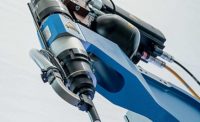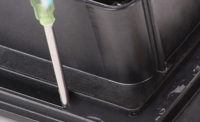If poet Gertrude Stein had also worked as an assembly machine operator, could she have ever written the line, “a rivet is a rivet is a rivet”? No one can say for sure, but it’s highly unlikely since operators know that rivets are distinctive in their design and function, as well as how they are installed.
One common installation method is impact riveting: a cold-forming process that permanently joins parts and is recommended for applications that require simultaneous insertion and heading of the rivet. As the name implies, an impact riveter upsets the rivet with a quick, powerful blow from the ram.
Home-products manufacturers use impact riveting in several applications. One such company, for example, has relied on the method to fasten metal brackets to attic doors since 2013. Initially, though, the application presented challenges related to installing semitubular rivets of two different lengths, feeding the rivets with a standard rotary hopper and aligning the door and bracket holes to achieve high productivity.
Bryan Wright, vice president of sales at Orbitform LLC, says the application requires 3.25- and 2.5-inch-long rivets with an oversized 0.5625-inch-diameter head. To meet this challenge, the manufacturer uses Orbitform’s Milford 423 machine, which is specifically designed to set long rivets and equipped with a changeover kit to easily handle both rivet lengths.
The feeding problem was solved because the 423 comes standard with a vibratory feeder bowl. For this application, the bowl diameter was increased from 14 to 18 inches to allow the 3.25-inch rivets to spread out for auto feeding.
Door and bracket hole alignment is quickened through the use of a machine rollset plunger (that extends 3 inches) and a manually operated foot pedal to lower the plunger into position. Once the door and bracket are in place, the worker releases the pedal so the plunger springs back and aligns the holes for quick rivet installation.
Because it is a low-tech process, impact riveting for a long time gained a reputation among manufacturers as a process strictly to be used for high-volume assemblies or those of low value or where tolerances are not particularly tight. Suppliers say these latter limitations no longer apply. Today’s machines install rivets to varying tolerances (loose or tight) and perform process monitoring, which ensures reliable joints in products ranging from low-cost toys and tools, to critical vehicle brake pads and high-end cookware.
An Oldie But Goodie
Performed for nearly a century, impact riveting is one of the oldest and most inexpensive and reliable methods of installing rivets for assembly. It is regularly used to assemble high-volume products, such as HVAC ductwork, fan blades, ladders, airplane headrests, lighting fixtures, fuses and circuit breakers, slide-drawer rollers, kitchen utensils, cookware and appliance components.
The impact process is typically semiautomatic and performed on a tabletop or pedestal (floor-mounted) machine that uses electromechanical, pneumatic, hydropneumatic or hydraulic force to install a rivet. This equipment may be integrated with a rotary indexing table or other automated assembly
system.
Impact riveting requires the machine operator to access both sides of the assembly. After placing parts (metal, plastic or rubber) in a fixture, he activates the machine by either pressing a button or stepping on a foot pedal. The rivet is fed from a hopper or a vibratory bowl, down a track, to open jaws that immediately close and insert the rivet shank into the part holes. A ram then strikes the rivet with enough compressive axial force to flatten the opposite end of the rivet and form a new head.
Machine tooling is unique to each application and includes custom jaws, a ram driver and an anvil, which determines the clinch shape. Kevin Klapperich, machine division manager at National Rivet & Manufacturing Co. (NRM), says failure to maintain the anvil can result in rivets that do not curl uniformly, have cracked curls or don’t securely fasten parts.
Rivet-insertion cycle time is 0.3 second to 3 seconds, depending on machine type. Klapperich says electromechanical machines are the fastest, thanks to a powerful flywheel that drives the ram and inserts the rivet within 0.3 to 0.5 second. On the downside, this type of machine is difficult to integrate with an automated production line.
“Electromechanical machines are extremely durable and made to run 24/7,” claims Klapperich. “One customer has been using the same machine since the 1940s to assemble ironing boards. Another operates one machine to assemble 16 different sizes of brakes for semitrailers.”
Pneumatic units require a bit longer insertion time, 0.5 to 1 second, but can be equipped with multiple wedge heads that simultaneously install several rivets. Shovel manufacturers often rely on this setup to insert six or eight rivets that secure a bottom strip to each shovel and improve its durability against snow and ice.
Wright says that several such companies employ the Milford Model 57 pneumatic riveting machine for this type of assembly. The Model 57 is also used by electronics companies to assemble fuse breakers. Available as a standalone unit or integrated into a workstation, the machine handles mild-steel semitubular rivets up to 0.19 inch in diameter.
Process Intelligence, Orbitform’s process monitoring technology, is optional. It enables manufactures to verify rivet presence and monitor forming force, pressure, ram stroke distance and other parameters for each assembly application.
Electromechanical dual-head machines also install multiple rivets. An offset driver accessory allows these heads, as well those on a pneumatic machine, to be positioned only 0.625 inch apart.
Hydropneumatic and hydraulic machines take 1 to 3 seconds to insert each rivet. This is because they are significantly larger and offer greater force capacity than electromechanical and pneumatic units.
Forming and Function
Joint characteristics can vary greatly depending on the rivet type, material and geometry. Common rivet types include solid, semitubular and self-piercing. Each has its own forming sequence, advantages and disadvantages. As a general rule, rivet length should not be more than five times its diameter. Maximum rivet length usually does not exceed 3.5 inches.
Riveting with solid rivets requires more force than with semitubular or self-piercing rivets to drive the rivet through a predrilled hole. The shank on a solid rivet must swell sufficiently to fill the hole before the head collapses.
“This creates a joint suitable for heavy-duty applications, and in some cases, it locks the joint to resist torque,” says Wright. “Multiple rivets are recommended for high torque joints. End-users need to remember, though, that higher forming force can potentially distort finished parts.”
According to Wright, high-capacity machines can install solid rivets up to 0.625 inch in diameter. Klapperich notes that customers use impact solid rivets as small as 0.028-inch diameter for eyeglasses and electrical switches.
Recently, NRM introduced its electromechanical Model 800 and 1000 rivet setters with a top-pin compensator that prevents truck and bus brake shoe linings from cracking during impact riveting. According to Klapperich, the brake lining manufacturing process can yield counterbores of slightly varying depths. With a thicker counterbore, the standard machine stroke could crack the linings. But, a slightly undersized counterbore might result in a loose rivet.
The top-pin compensator features a rocker arm, toggle linkage and spring (with preset tension) that automatically compensates for varying lining thicknesses (±0.0625 inch) and accommodates different rivet lengths (±0.125 inch). “These riveters offer a cycle time of 0.33 second, enabling an experienced operator to rivet a brake shoe faster than with a dual hydraulic machine,” claims Klapperich.
Grant Riveters offers several impact riveting machines. The Edward Segal P250-P pneumatic riveter is used for furniture, framing, automotive sheet metal piercing and various tubular products. It handles solid and semitubular rivets up to 0.3125 inch diameter and 1.625 inches long. Standard features include a single spindle, a 3-inch ram stroke, a 16-inch throat and a 14-inch vibratory bowl feed system. The pedestal machine has a 42-inch working height and a 24-by-36-inch footprint.
“Some manufacturers use impact riveting with a solid rivet because it distorts (swells),” notes Bruce McNaughton, president of Grant Riveters, which has made riveting machines since 1880. “If that type of rivet provides the best fit to the components and sufficient mechanical support, then it’s the best riveting option for that application.”
The semitubular rivet features thin shank walls and a body diameter of 0.06 to 0.3 inch. During installation, the rivet passes through a predrilled clearance hole and the tubular portion of the shank curls over on impact, drawing the parts together with minimal shank swell. These rivets typically require around 40 percent less force to form than solid impact rivets, resulting in less part distortion.
Solid and semitubular rivets are typically steel, but they can be made of aluminum, brass and stainless steel. A variety of head styles and finishes are available. Both types of rivets can be inserted to a tight or loose fit in the hole.
Loose rivets are particularly well-suited for products that require pivot joints or mechanical repetitiveness. They also allow high production rates, are easy to inspect and require no maintenance. McNaughton cites products as diverse as hand tools and furniture as perfect candidates for loose rivets.
“A product design can use a loose rivet, provided there is suitable access to the preformed rivet head and if the assembly supports the rivet from collapsing during the heading process,” notes McNaughton. “On the other hand, avoid a loose rivet design when the access isn’t adequate or where the head forming operation is located in a restricted or obstructed area.”
Self-piercing rivets are semitubular and made of hardened steel. They are often used to join two thin sheets of metal or other materials. A driver punches the rivet and sheet metal into a die, causing the rivet to pierce the top layer and displace the bottom layer into a pocket in the anvil. This creates a button shape similar to clinching.
One big advantage of self-piercing rivets is they do not require a pre-drilled clearance hole, saving time and a process. However, with the absence of a hole, applications may require external fixturing to align the parts. Self-piercing rivets also offer the flexibility of shifting the rivet location during assembly, although they are not recommended for hard or thick metals.
Consistent Expectations
Wright says that the popularity of impact riveting has been consistent for many years, and he foresees it staying that way in the future. He cites two reasons for this: The process is fast and simple, and the machines are robust, operator friendly and require minimal maintenance.
In recent years, as end-users have placed a greater emphasis on safety, suppliers have responded in kind. Most models now feature a safety probe, which has a small-diameter tube configured in a halo. This halo moves from the ram to the part to detect no interference prior to the ram advancing during the forming process.
Although the standard probe is OSHA approved, it can limit throughput by making it difficult to load the components being assembled, notes Wright. Aware of this, Orbitform developed a robust pneumatic safety probe in 2015 that is shorter and mounted next to the ram. It allows maximum load clearance and helps increase throughput. The probe is offered as an option, although Wright says the company strongly recommends that its customers use a safety probe on every machine to satisfy OSHA
requirements.
NRM makes standard and custom impact riveting machines, as well as a complete range of rivets. Klapperich says NRM’s custom machines can be quite complex and, increasingly, they feature force sensors and inspection cameras to ensure top-notch assemblies. He also emphasizes the importance of using high-quality rivets that truly meet the performance demands of each specific product.
“Nearly 95 percent of the rivets we produce are custom made,” notes Klapperich. “After the manufacturer provides us part-design prints with the material stack height and required hole size, we determine the proper rivet for the application—including its shank design, metal type, length, diameter and if it needs plating.”






